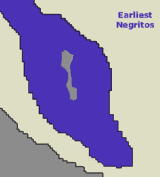
[Jabatan Hal Ehwal Orang Asli]
The Orang Asli are the indigenous minority peoples of Peninsular Malaysia. The name is a Malay term which transliterates as 'original peoples' or 'first peoples.' It is a collective term introduced by anthropologists and administrators for the 18 sub-ethnic groups generally classified for official purposes under Negrito, Senoi and Proto-Malay. Nowadays there about 60.000 Orang Asli people, of which 60% still live in the rain forest. About 40% Orang Asli live along or near the coast. Each has its own language and culture, and perceives itself as different from the others. They numbered 105,000 in 1997 representing a mere 0.5 per cent of the national population.
The Orang Asli, nevertheless, are not a homogeneous group. Each has its own language and culture, and perceives itself as different from the others. Linguistically, some of the northern Orang Asli groups (especially the Senoi and Negrito groups) speak languages - now termed Aslian languages - that suggest a historical link with the indigenous peoples in Burma, Thailand and Indo-China.

The members of the Proto-Malay tribes, whose ancestors were believed to have migrated from the Indonesian islands to the south of the peninsula, speak dialects which belong to the same Austronesian family of languages as Malay, with the exceptions of the Semelai and Temoq dialects (which are Austroasiatic).
The Orang Asli have equally varied occupations and ways of life. The Orang Laut, Orang Seletar and Mah Meri, for example, live close to the coast and are mainly fishermen. Some Temuan, Jakun and Semai people have taken to permanent agriculture and now manage their own rubber, oil palm or cocoa farms.
About 40 per cent of the Orang Asli population - including Semai, Temiar, Che Wong, Jah Hut, Semelai and Semoq Beri - however, live close to, or within forested areas. Here they engage in swiddening (hill rice cultivation) and do some hunting and gathering. These communities also trade in petai, durian, rattan and resins to earn cash incomes.
A very small number, especially among the Negrito groups (such as Jahai and Lanoh) are still semi-nomadic, preferring to take advantage of the seasonal bounties of the forest. A fair number also live in urban areas and are engaged in both waged and salaried jobs.

Location of Orang Asli groups,
and the evolution of settlers on the
Malay Peninsula
WHO ARE THE MAH MERI?

The Mah Meri (Mah meaning people and Meri meaning forest), originally known as the Besisi, also call themselves Ma Betisek, which means, "people with fish scales". The Mah Meri are one of the nineteen Orang Asli people groups of Peninsular Malaysia. They are officially classified under Senoi subgroup. There is no information on their origin, but the Mah Meri tribe claims to have walked the earth for as long as one can remember. Most of Mah Meri people live in Carey Island(Pulau Carey). According to the Orang Asli Office of the Malaysian government, they numbered around 2200 in 2005.
Political Organization
In common with other Orang Asli Villages, each kampung elects its own Batin (Village Headman) and a council of 'elders' to represent the people living in the kampung. The Batin is paid an annual salary by the Malaysian government. The Bomoh, who functions as a shaman in their society, plays an important role in the kampung.
Mah Meri's villages:-
Kampung Orang Asli Bukit Bangkong
Kampung Orang Asli Sungei Kurau
Kampung Orang Asli Sungei Judah
Kampung Orang Asli Sungei Bumbun
Kampung Orang Asli Sungei Jugra
[Back to Main Site]
No comments:
Post a Comment